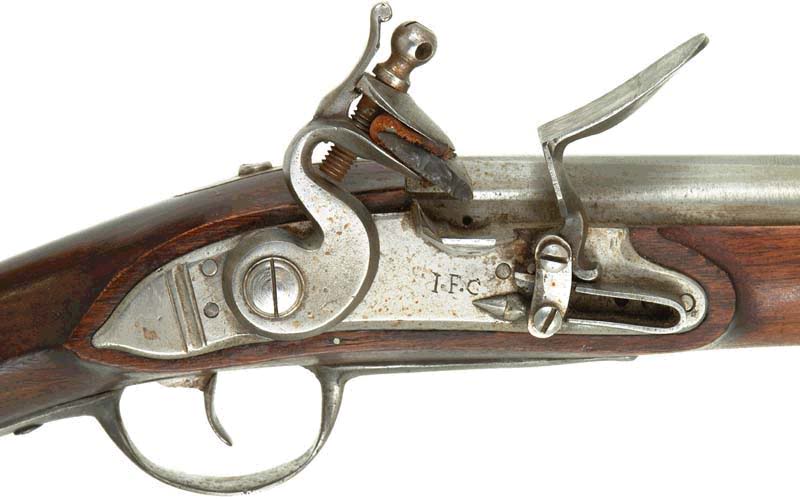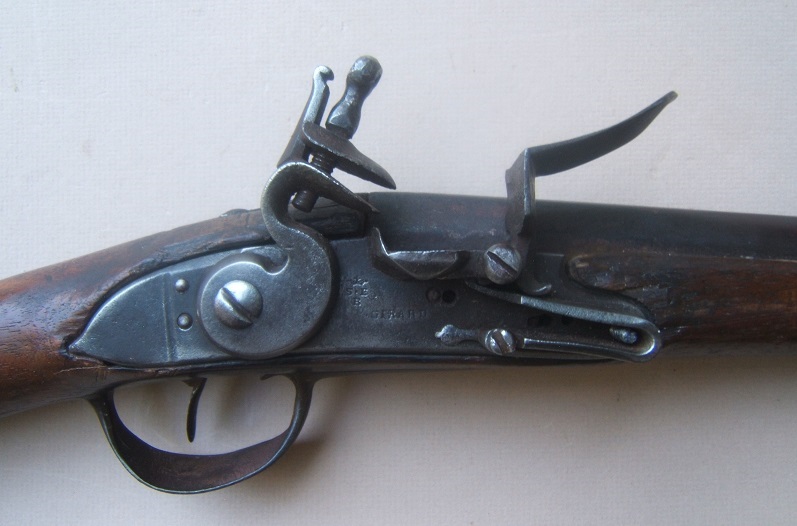Ike Godsey
45 Cal.
Howdy!!
I just ran across a flinter that was new to me, so I thought I share it with you.
Well, at the beginning, it startet its life as a French 1717 musket. I am sure you all know the specs: 46“ barrel, which was pinned to the stock, .69 Cal., and its most unusaual feature, the ”žvertical bridle“ from the frizzen tot he frizzen spring.


We also all know that many people say, the 1717 was not in America before the AWI.
Well, that maybe true, maybe not. From what I red about ”žarming the colonies“ ”“ and I assume that is also correct for the French ”“ they send the obsolet gun overseas.
So why not the 1717??
Is this an exeption??
If so, why??
Like I said earlier, I ran across a musket that was new to me. It is a 1717 French Musket which was cut back to 36 something Inch barrel. OK, so far so good, we know that was done to many muskets also Bessies.
This ist he gun I ran across:
http://www.skinnerinc.com/auctions/2856M/lots/264
The worte 1717/1728 ”“ but it is clearly a 1717 musket, hence the pinned barrel.
But we also know the fact, that the lock of the 1717 is larger than the lock of the 1728.
So if you look to the pics in the Link above you’ll see there is the vertical bridle missing, but there is a bridle from the pan to the frizzen-screw. Since the lock fits in snugg, I assume the lock is newly made to upgrade the 1717 musket.
Searching the web, I ran across some other pics of the same type of musket, but this time in ist full length:


Anyone got more infos about this modification?
What was the reason for newly made locks?
Are there are more 1717s around?
Any help on this welcome.
Ike
I just ran across a flinter that was new to me, so I thought I share it with you.
Well, at the beginning, it startet its life as a French 1717 musket. I am sure you all know the specs: 46“ barrel, which was pinned to the stock, .69 Cal., and its most unusaual feature, the ”žvertical bridle“ from the frizzen tot he frizzen spring.


We also all know that many people say, the 1717 was not in America before the AWI.
Well, that maybe true, maybe not. From what I red about ”žarming the colonies“ ”“ and I assume that is also correct for the French ”“ they send the obsolet gun overseas.
So why not the 1717??
Is this an exeption??
If so, why??
Like I said earlier, I ran across a musket that was new to me. It is a 1717 French Musket which was cut back to 36 something Inch barrel. OK, so far so good, we know that was done to many muskets also Bessies.
This ist he gun I ran across:
http://www.skinnerinc.com/auctions/2856M/lots/264
The worte 1717/1728 ”“ but it is clearly a 1717 musket, hence the pinned barrel.
But we also know the fact, that the lock of the 1717 is larger than the lock of the 1728.
So if you look to the pics in the Link above you’ll see there is the vertical bridle missing, but there is a bridle from the pan to the frizzen-screw. Since the lock fits in snugg, I assume the lock is newly made to upgrade the 1717 musket.
Searching the web, I ran across some other pics of the same type of musket, but this time in ist full length:


Anyone got more infos about this modification?
What was the reason for newly made locks?
Are there are more 1717s around?
Any help on this welcome.
Ike
Last edited by a moderator:




























